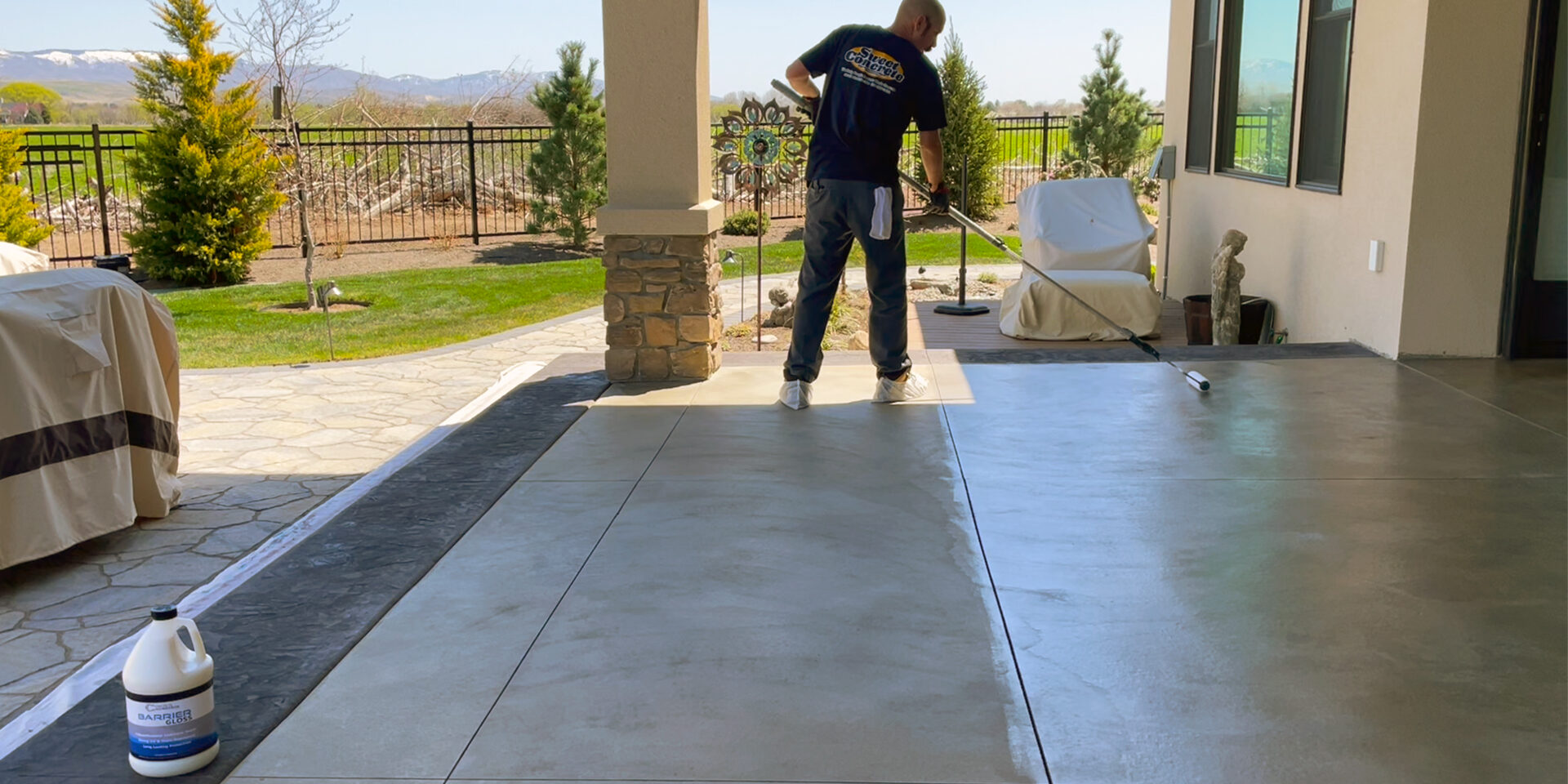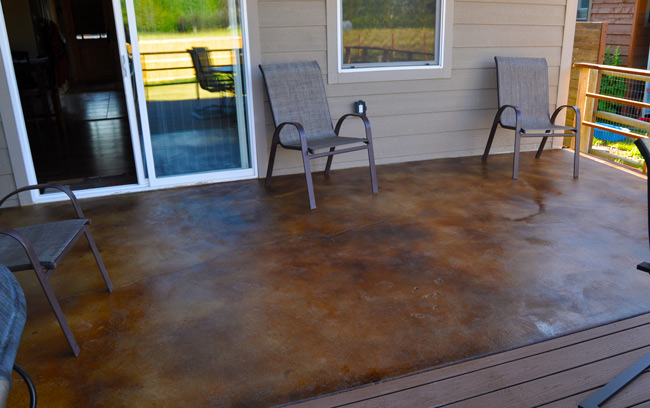Comprehending the Different Kinds of Stained Concrete for Your Following Job
Stained concrete deals different options that satisfy various visual and useful requirements. Each kind presents unique attributes that influence the last appearance and toughness of the surface. Understanding these distinctions is crucial for any person intending a job. From rich, chain reactions of acid-based stains to the lively harmony of solid shade stains, the choices can significantly impact the result. What aspects should one think about when selecting the ideal tarnish for their certain demands?
Summary of Stained Concrete
Stained concrete works as a versatile flooring choice that can improve the aesthetic appeal of different rooms. This strategy includes applying a tinting agent to the surface area of existing concrete, enabling a broad spectrum of design opportunities. Stained concrete is popular in both residential and commercial settings, using a durable and low-maintenance service that can simulate the look of all-natural products like stone or tile.
The discoloration process can be executed utilizing water-based or solvent-based products, each supplying unique visual impacts. The final look is affected by elements such as the original concrete surface, the sort of tarnish utilized, and the application approach. Stained concrete not only improves insides and outsides but also advertises sustainability by revitalizing existing concrete structures. As an outcome, it has actually obtained traction amongst home owners and designers seeking both performance and style in their flooring options.
Acid-Based Stains: Attributes and Advantages

Distinct Color Variations
Concrete surface areas can transform substantially with the application of acid-based stains, which use a rich scheme of special shade variations. These stains penetrate the concrete, reacting chemically to generate dynamic planet tones that vary from deep browns and reds to soft greens and blues. The resulting colors are often variegated, producing an all-natural, marble-like appearance that improves the concrete's personality. Each application yields distinctive results because of variants in the concrete's composition and the staining technique utilized, making every job distinct. In addition, acid-based stains can be split or combined with various other strategies to produce tailored layouts, enabling personal expression. This flexibility makes acid-based stains a prominent selection for both domestic and industrial applications.
Chain Reaction Described
While numerous aspects add to the efficiency of acid-based stains, the underlying chain reaction play an important function in their distinct characteristics and advantages. These stains mostly contain water, acid, and metal salts. When applied to concrete, the acid reacts with the calcium hydroxide in the cement, creating a chemical change that leads to permanent color changes. The metal salts pass through the surface area and bond with the concrete, permitting for a variety of shades and tones. This response not only enhances visual charm yet additionally gives sturdiness, making the color resistant to fading and wear. Additionally, acid-based stains can develop a variegated finish that resembles natural rock, additional boosting their appeal for attractive concrete applications.
Surface Area Preparation Significance
Accomplishing suitable results with acid-based stains rests on thorough surface area preparation. This vital step assurances that the concrete surface area is clean, cost-free of pollutants, and effectively profiled for optimal tarnish absorption. Any type of existing sealants, dirt, or oils can prevent the chemical reaction that generates the desired shade and coating, resulting in unequal or patchy results.
Before using the stain, the concrete needs to be mechanically cleansed or stress cleaned, adhered to by a comprehensive inspection for splits or imperfections that might need repair service. Furthermore, validating the surface is properly dried will certainly enhance stain adherence. By focusing on these primary steps, the durability and vibrancy of acid-based stains can be considerably enhanced, resulting in a much more visually pleasing and durable surface.
Water-Based Stains: Features and Benefits

Water-based stains pass through the concrete, providing an extra translucent coating that highlights the natural appearance and variations of the surface area below. They are offered in a wide array of shades, allowing for imaginative flexibility in style. In addition, water-based stains are easier to tidy up, requiring only water and soap, which streamlines the application process.
Their quick drying out time boosts effectiveness, making them a practical option for both DIY lovers and experts. On the whole, water-based stains supply an enticing mix of aesthetic flexibility and easy to use residential or commercial properties, making them a prominent choice for concrete improvement tasks.
Solid Color Stains: Vibrant Choices for a Vibrant Appearance
Strong color stains supply an effective service for those looking for to develop a bold and vibrant aesthetic on concrete surface areas. These stains give a consistent pigmentation that can drastically improve the aesthetic appeal of floors, outdoor patios, and driveways. Available in a broad range of shades, strong color stains permit innovative expression, accommodating various layout choices.
One of the crucial benefits of solid color stains is their capacity to hide blemishes, providing a fresh and polished seek to maturing concrete - Stained Concrete Austin. Furthermore, their formulation generally consists of important link UV-resistant properties, ensuring long life and shade retention even in severe climate condition
Application is simple, requiring minimal prep work of the concrete surface. Once used, solid shade stains can be sealed for included defense and shine, further boosting their aesthetic top quality. With their lively options, strong shade stains are a superb selection for those going for an impactful and natural style.
Semi-Transparent Stains: Achieving Deepness and Dimension
Semi-transparent stains offer an one-of-a-kind approach to enhancing concrete surface areas by providing deepness and measurement with numerous shade alternatives. Recognizing the application techniques is important for accomplishing the wanted effect, while correct maintenance techniques assure longevity. This section will certainly check out these vital elements to make best use of the benefits of semi-transparent staining.
Shade Options Available
A wide array of color choices exists for semi-transparent stains, permitting house owners and developers to enhance the all-natural elegance of concrete surface areas. These stains come in an array of hues, from earthy tones like browns and terracottas to vivid colors such as blues and greens. The semi-transparent nature of these stains enables the underlying concrete to reveal via, creating an unique deepness and dimension that can match various style aesthetics. Additionally, incorporating various colors can generate personalized shades, allowing a tailored try to find each project. This adaptability makes semi-transparent stains a popular selection for both interior and exterior applications, as they can harmonize with surrounding elements while adding visual rate of interest to simple concrete.
Application Techniques Explained
To achieve the wanted depth and measurement with semi-transparent stains, proper application strategies are essential. Surface area prep work is crucial; the concrete must be clean and complimentary of any kind of impurities. This frequently entails power washing and fixing any cracks. Next off, picking the ideal applicator, such as a sprayer, roller, or brush, can influence the last appearance. Sprayers enable a more even application, while rollers can aid accomplish structure. It is necessary to apply the stain in slim, also layers, permitting each layer to completely dry before adding another. Adjusting the application strategy, such as differing pressure or using various tools, can create unique results. Lastly, securing the stained surface enhances the vibrancy of the shades while offering protection.
Maintenance Ideal Practices
Normal upkeep is crucial for protecting the charm and honesty of surfaces treated with semi-transparent stains. To keep these surfaces, routine cleansing is vital. Utilizing a pH-neutral cleaner and a soft-bristle broom will aid remove dust and particles without damaging the discolor. It is a good idea to avoid extreme chemicals, as they can weaken the stain's appearance. Additionally, regular resealing each to 3 years can safeguard versus wear and fading. This procedure involves cleaning up the surface area thoroughly and applying a compatible sealant created for stained concrete. House owners should also monitor for any type of indicators of discoloration or damage and address these issues immediately to assure long-lasting vibrancy and toughness. Adhering to these best practices will certainly improve the overall life expectancy of semi-transparent stained surface areas.
Effects and Techniques: Tailoring Your Stained Concrete
Tailoring stained concrete includes an array of methods that improve both aesthetics and performance. Amongst these approaches, layering different discolor shades can develop deepness and complexity, allowing for distinct aesthetic effects. Techniques such as acid staining offer a variegated look, while water-based stains supply a much more consistent appearance.
In addition, including ornamental patterns, such as stenciling or inscription, can better individualize the surface area, adding elaborate designs that satisfy individual preferences. Texturing the concrete, whether through stamping or mop finishes, presents tactile elements that not just enhance pop over to this site hold but also boost aesthetic rate of interest.
Moreover, using sealers can enhance the shade vibrancy and give security against wear. Personalization strategies prolong beyond mere color; they can change Our site a common concrete slab into a magnificent prime focus, making it ideal for both property and industrial spaces. Through cautious choice of impacts and strategies, stained concrete can accomplish a really tailored appearance.
Maintenance and Long Life of Stained Surfaces
Stained concrete surfaces are known for their toughness and aesthetic charm, keeping their integrity is necessary for making certain long life. Normal cleansing is crucial; sweeping and mopping with a pH-neutral cleaner helps protect against dirt accumulation and staining. Furthermore, using a sealer every couple of years can secure the surface from wetness, chemicals, and UV damages, thus enhancing its lifespan.
It is additionally crucial to attend to any type of splits or chips quickly. Little repair services can alleviate additional degeneration, preserving the aesthetic and architectural high quality of the surface. For exterior stained concrete, seasonal maintenance, such as removing snow and ice, is essential to avoid surface area damage from freeze-thaw cycles.
Frequently Asked Questions
Can I Stain Existing Concrete Surfaces or Brand-new Ones?
The inquiry of whether existing concrete surface areas can be stained arises often. It is indeed possible to discolor both new and old concrete, provided the surface is properly prepared and free of contaminants for excellent bond.
How much time Does the Discoloration Refine Typically Take?
The staining procedure commonly takes one to three days, relying on aspects such as surface area preparation, kind of tarnish, and climate conditions. Stained Concrete Austin. Healing time may prolong beyond first application, influencing the general duration considerably
Is Stained Concrete Safe for Outdoor Usage?
Stained concrete is generally secure for exterior usage, supplied it is correctly sealed. This sealing safeguards versus dampness and UV damages, ensuring durability and safety and security, while likewise improving the aesthetic allure of outside areas.
Can I Apply Numerous Spot Layers for Various Results?
Applying multiple discolor layers can accomplish diverse results on stained concrete. Nevertheless, it is essential to guarantee compatibility in between stains and allow correct drying out time between applications to prevent unintentional responses or staining.
Are There Any Type Of Color Limitations for Stained Concrete?
Color restrictions for stained concrete mainly rely on the kind of discolor used, with water-based stains offering a broader combination contrasted to acid-based stains. Stained Concrete Floors Austin. Accomplishing lively shades might call for careful choice and application strategies.